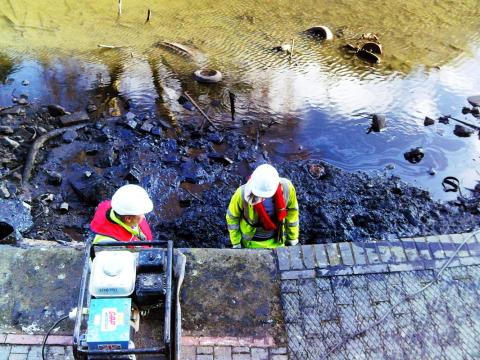Trust issues safety warning to summer swimmers
June 2017 - Many boaters have come across youngsters swimming in the canals, even jumping and diving into locks as hot weather draws them to the canalside – but it is a prospect that – rightly – makes Canal River Trust nervous, as Peter Underwood reports.
It's pretty common for older boaters to complain about the 'health and safety' culture of the modern waterways, but the consequences of not protecting the public with effective health and safety rules has come home to all but the most dyed-in-the-wool in recent weeks.
Water, like fire, is one of the core elements of life that both sustains and destroys people – and around 200 people a year drown in inland waters.
It is not difficult to understand why if you cruise the summer waterways. In addition to risk-taking youngsters diving and swimming from the towpaths it is far from unusual to see young children running on the roofs of holiday boats or dangling their feet from the bow as the boat moors or enters a lock.
A few years ago I found myself screaming at four youngsters standing on the roof of a hire boat about to pass under a motorway bridge. The steerer had failed to see the concrete apron sticking out into the canal and smacked into it just after I shouted to his children to lay flat on the roof – and started abusing me for shouting at his children soon after.
The Canal & River Trust, perhaps more aware than usual that public bodies who don't get health and safety right are now less likely to get away without reputational damage, has spelled out the risks and is urging people not to swim in its waters.
Even if a tiny fraction of one per cent of the 385 million visits C&RT claims are made by boaters, cyclists, runners, walkers and canoeists, result in a fatality, the Trust rightly takes the view that one death is too many.
It spells out the risks:
- Canal and river water is usually murky so you can’t see the depth – it could be much shallower than you expect it to be and cause serious harm if someone jumps in, as well as being much deeper than expected in other areas
- In busy areas, rubbish, like shopping trolleys, can trap your feet as well as cause injury
- Reeds and other plant life can get tangled around limbs and keep you in the water;
- There are waterborne diseases such as Leptospirosis (Weil’s disease) which, if left untreated, can be fatal;
- Low temperatures can cause the blood to rush away from your muscles to protect your organs and limbs and muscles may become fatigued quickly - this can lead to drowning.
Health and Safety boss, Tony Stammers, says: “Spending time along a canal or river is a lovely way to spend a summer’s day and they are excellent places for families to explore during the holidays. But it’s also important that people, especially children and teenagers, are aware of the dangers of cooling off by going for a dip. The consequences can be devastating."
Mel Goodship’s 17-year-old son James drowned in June 2014 while swimming with friends in Foulridge Reservoir, Lancashire.
Mel says: "James used to mess around in the water with his friends; he was a strong swimmer so we just thought he’d be fine. We had never sat our children down and explained the dangers of the water, I didn’t really know what they were myself. The shock of the cold water paralysed his muscles, took his energy and took his life.
“If you’re thinking about getting into any stretch of water which isn’t supervised, please don’t."
Tony Stammers continues: "Inland waterways, like canals, rivers and docks, can look really inviting but you can’t tell what is below the surface. The water is often murky and you won’t be able to see the depth or any obstacles in the water. We’re asking people to find another way to cool off this summer – have an ice cream, stay in the shade, go for a swim at your local pool. Please don’t get in the water, it’s just not worth it."
And there is a footnote that all boaters should be well aware of, as even a small area of broken skin coming into contact with canal water can kill.
Waterborne diseases, including Weil’s Disease (leptospirosis), are extremely rare, but if you are swimming, or you fall in from our boat, you're most exposed to them. Waterway users frequently catch Weils Disease and all too often fail to get the correct treatment immediately.
There a few commonsense precautions:
- If you’ve got any cuts or scratches, keep them covered.
- If you fall in, take a shower and treat cuts with antiseptic and a sterile dressing.
- Wash wet clothing before you wear it again.
- If you develop flu-like symptoms within two weeks, see a doctor and mention that you fell in the water. Not all doctors will know to look for signs of Weil’s Disease, so do suggest it as a possibility.
Photos: (1st) A summer scene, but not a place to swim in murky - and possibly diseased - waters, (2nd) The bottom of the canal at Gas Street in Birmingham - littered with discarded metal and old tyres.







